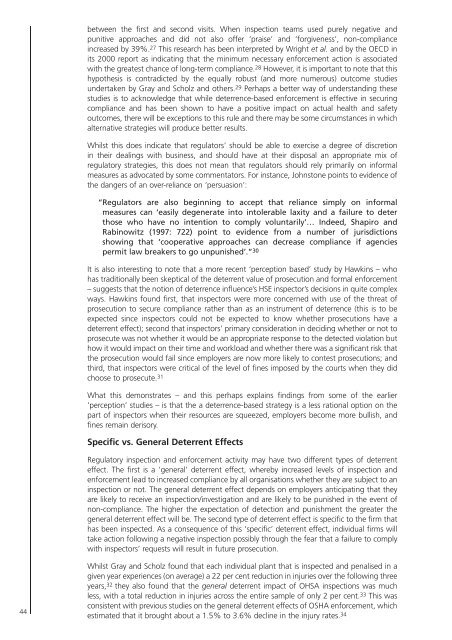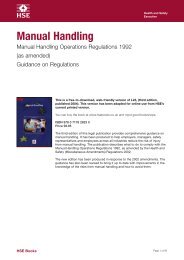Making Companies Safe - what works? (CCA ... - Unite the Union
Making Companies Safe - what works? (CCA ... - Unite the Union
Making Companies Safe - what works? (CCA ... - Unite the Union
You also want an ePaper? Increase the reach of your titles
YUMPU automatically turns print PDFs into web optimized ePapers that Google loves.
etween <strong>the</strong> first and second visits. When inspection teams used purely negative and<br />
punitive approaches and did not also offer ‘praise’ and ‘forgiveness’, non-compliance<br />
increased by 39%. 27 This research has been interpreted by Wright et al. and by <strong>the</strong> OECD in<br />
its 2000 report as indicating that <strong>the</strong> minimum necessary enforcement action is associated<br />
with <strong>the</strong> greatest chance of long-term compliance. 28 However, it is important to note that this<br />
hypo<strong>the</strong>sis is contradicted by <strong>the</strong> equally robust (and more numerous) outcome studies<br />
undertaken by Gray and Scholz and o<strong>the</strong>rs. 29 Perhaps a better way of understanding <strong>the</strong>se<br />
studies is to acknowledge that while deterrence-based enforcement is effective in securing<br />
compliance and has been shown to have a positive impact on actual health and safety<br />
outcomes, <strong>the</strong>re will be exceptions to this rule and <strong>the</strong>re may be some circumstances in which<br />
alternative strategies will produce better results.<br />
Whilst this does indicate that regulators’ should be able to exercise a degree of discretion<br />
in <strong>the</strong>ir dealings with business, and should have at <strong>the</strong>ir disposal an appropriate mix of<br />
regulatory strategies, this does not mean that regulators should rely primarily on informal<br />
measures as advocated by some commentators. For instance, Johnstone points to evidence of<br />
<strong>the</strong> dangers of an over-reliance on ‘persuasion’:<br />
“Regulators are also beginning to accept that reliance simply on informal<br />
measures can ‘easily degenerate into intolerable laxity and a failure to deter<br />
those who have no intention to comply voluntarily’… Indeed, Shapiro and<br />
Rabinowitz (1997: 722) point to evidence from a number of jurisdictions<br />
showing that ‘cooperative approaches can decrease compliance if agencies<br />
permit law breakers to go unpunished’.” 30<br />
It is also interesting to note that a more recent ‘perception based’ study by Hawkins – who<br />
has traditionally been skeptical of <strong>the</strong> deterrent value of prosecution and formal enforcement<br />
– suggests that <strong>the</strong> notion of deterrence influence’s HSE inspector’s decisions in quite complex<br />
ways. Hawkins found first, that inspectors were more concerned with use of <strong>the</strong> threat of<br />
prosecution to secure compliance ra<strong>the</strong>r than as an instrument of deterrence (this is to be<br />
expected since inspectors could not be expected to know whe<strong>the</strong>r prosecutions have a<br />
deterrent effect); second that inspectors’ primary consideration in deciding whe<strong>the</strong>r or not to<br />
prosecute was not whe<strong>the</strong>r it would be an appropriate response to <strong>the</strong> detected violation but<br />
how it would impact on <strong>the</strong>ir time and workload and whe<strong>the</strong>r <strong>the</strong>re was a significant risk that<br />
<strong>the</strong> prosecution would fail since employers are now more likely to contest prosecutions; and<br />
third, that inspectors were critical of <strong>the</strong> level of fines imposed by <strong>the</strong> courts when <strong>the</strong>y did<br />
choose to prosecute. 31<br />
What this demonstrates – and this perhaps explains findings from some of <strong>the</strong> earlier<br />
‘perception’ studies – is that <strong>the</strong> a deterrence-based strategy is a less rational option on <strong>the</strong><br />
part of inspectors when <strong>the</strong>ir resources are squeezed, employers become more bullish, and<br />
fines remain derisory.<br />
Specific vs. General Deterrent Effects<br />
Regulatory inspection and enforcement activity may have two different types of deterrent<br />
effect. The first is a ‘general’ deterrent effect, whereby increased levels of inspection and<br />
enforcement lead to increased compliance by all organisations whe<strong>the</strong>r <strong>the</strong>y are subject to an<br />
inspection or not. The general deterrent effect depends on employers anticipating that <strong>the</strong>y<br />
are likely to receive an inspection/investigation and are likely to be punished in <strong>the</strong> event of<br />
non-compliance. The higher <strong>the</strong> expectation of detection and punishment <strong>the</strong> greater <strong>the</strong><br />
general deterrent effect will be. The second type of deterrent effect is specific to <strong>the</strong> firm that<br />
has been inspected. As a consequence of this ‘specific’ deterrent effect, individual firms will<br />
take action following a negative inspection possibly through <strong>the</strong> fear that a failure to comply<br />
with inspectors’ requests will result in future prosecution.<br />
44<br />
Whilst Gray and Scholz found that each individual plant that is inspected and penalised in a<br />
given year experiences (on average) a 22 per cent reduction in injuries over <strong>the</strong> following three<br />
years, 32 <strong>the</strong>y also found that <strong>the</strong> general deterrent impact of OHSA inspections was much<br />
less, with a total reduction in injuries across <strong>the</strong> entire sample of only 2 per cent. 33 This was<br />
consistent with previous studies on <strong>the</strong> general deterrent effects of OSHA enforcement, which<br />
estimated that it brought about a 1.5% to 3.6% decline in <strong>the</strong> injury rates. 34
















